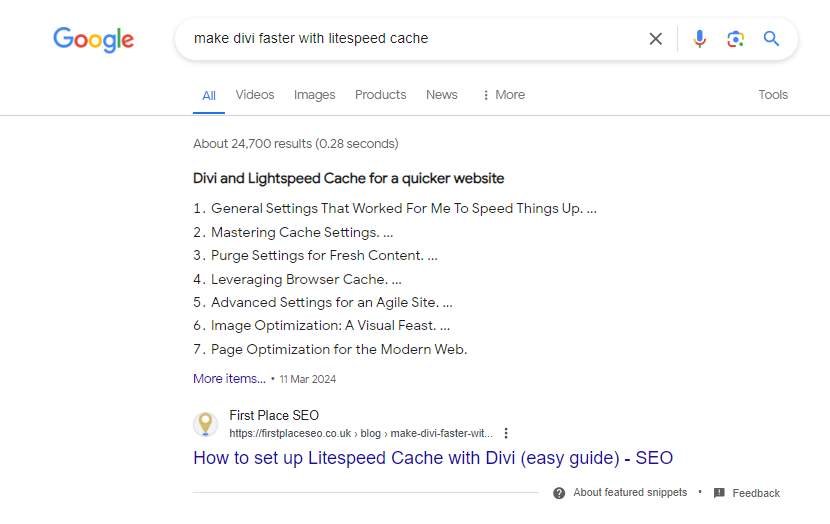What Are Rich Snippets In SEO?
Rich snippets in SEO are special displays in search engine results that offer more detailed information about the content of a web page than the standard listing. They are generated from structured data markup added to the HTML of a webpage, which helps search engines understand specific details about the content.
For example, if you have a cooking blog, adding structured data to your recipe pages can result in rich snippets that might show a photo of the dish, ratings, cooking time, and calorie information right in the search results. This makes your listing stand out and provides valuable information to users even before they click through to your site.
Rich snippets can cover a wide range of content types, including products, recipes, reviews, events, and more. By enhancing the visibility and attractiveness of your search results, rich snippets can improve click-through rates, driving more traffic to your website. This additional layer of information helps users make more informed decisions directly from the search page, often leading to higher engagement and satisfaction with the content they find.

Do rich snippets improve SEO?
Yes rich snippets improve SEO as they are directly related to better user experience, click through rate and time spent on page.
They provide users with more relevant information directly at the top of the search results. When you are at the top of search results you get more clicks and this increased user engagement signals to search engines that the content is valuable and deserving of the higher rankings.
Rich snippets are great because they give quick access to key information, such as ratings, reviews, and pricing details. This added context helps users make informed decisions without having to click through to the website, thereby reducing bounce rates and increasing page dwell time.
What are the differences between featured snippets and rich snippets in SEO?
Rich snippets and featured snippets are both tools used in SEO to enhance the visibility of search results on Google, but they serve different purposes and appear differently on the search engine results page (SERP).
Rich Snippets: Rich snippets are enhanced organic search results that include additional information derived from structured data on a webpage. This information might include ratings, prices, author details, or other relevant data that provides more details about the page’s content. Rich snippets are aimed at improving the user’s understanding of what the page offers before they click through, potentially increasing click-through rates.
Featured Snippets: Featured snippets, on the other hand, are a type of search result that appears above the traditional organic search results—often referred to as “Position Zero.” They are designed to directly answer a searcher’s query and are pulled from the content of a webpage. A featured snippet can be a paragraph, a list, or a table, and includes a summary of the answer extracted from the webpage, along with the page’s title and URL.
The key difference is that rich snippets enhance existing results by adding more detailed information, while featured snippets aim to provide an immediate answer to a query right at the top of the search results, often removing the need for the user to click through to the site for more basic queries.
How do featured snippets affect SEO?
Featured snippets, also known as answer boxes, have a BIG impact on SEO by influencing search results and website traffic. These snippets provide users with concise answers to their queries directly on the search results page, positioned above the organic search results.
From an SEO perspective, appearing in a featured snippet can significantly boost a websites visibility and organic traffic. Websites that secure featured snippets often experience higher click-through rates, as users are more likely to click on the snippet for a quick answer.
Another top benefit of featured snippets is that they enhance a brand credibility and authority by positioning the website as an authoritative source of information. This increased visibility and credibility can indirectly impact SEO performance by attracting more inbound links and social shares.
How many types of snippets are there?
At the moment there are 13 types of snippets! Google supports a wide variety of snippets, each tailored to different types of content to enhance their appearance in search results. Here are some of the main types:
- Article: For news, sports, or blog articles, showing more elaborate details like the title and images.
- Book Actions: Allows users to purchase books directly from search results.
- Breadcrumb: Displays the page’s position in the site hierarchy.
- Carousel: Shows a sequence of images or products in a gallery format.
- Course Info: Details about educational courses, including ratings and pricing.
- Event: Lists events like concerts or festivals with details on time and place.
- FAQ: Shows a list of frequently asked questions and their answers.
- Job Posting: Details about job openings, including the organization logo and job specifics.
- Local Business: Information about local businesses, such as opening hours and location.
- Product: Information about products, including prices, availability, and reviews.
- Recipe: Recipes that may appear as individual results or within a carousel, including ingredients and cooking times.
- Review Snippet: Shows excerpts of reviews or ratings from review websites.
- Video: Displays video content and can include options to play directly in search results.
These rich snippets are generated from structured data markup that webmasters can add to their websites. By implementing the appropriate structured data, website owners can help their content stand out in search results, making it more likely that users will click through to their sites.
What will be the next type of snippet?
Google is introducing a new type of snippet called Search Generative Experience (SGE) which is an innovative search interaction where generative AI directly responds to user queries. Displayed as SGE snippets or AI-powered summaries on the search engine results page (SERP), this feature allows users to engage further with AI through a dedicated chat interface, enhancing the search experience by providing immediate, conversational assistance. It will really shake up the current format.
When should you optimize for rich snippets?
You should optimize for rich snippets when you aim to enhance the visibility and interaction with your content on search engine results pages (SERPs). This is particularly beneficial when:
You have content that matches rich snippet types: If your website includes content such as products, recipes, reviews, events, or FAQs, these are ideal candidates for rich snippets, which can display additional information like ratings, prices, or event dates directly in search results.
You want to improve click-through rates (CTR): Rich snippets make search results more attractive and informative, potentially increasing the likelihood that a searcher will click on your result.
You’re focused on providing direct answers: If your content can satisfy queries directly from the SERPs, such as answering specific questions or providing clear definitions, optimizing for rich snippets can be particularly effective.
Your competition uses them: If competitors are using rich snippets to stand out in SERPs, not utilizing them could put you at a disadvantage.
To prepare for future SEO benefits: While not currently a direct ranking factor, structured data (which powers rich snippets) helps search engines understand your content better, which could indirectly benefit your site’s ranking.
Optimizing for rich snippets involves using structured data to mark up your content, making it easier for search engines to parse and display it in an enhanced format.
How do I get ranking in Google Rich Snippets?
Ranking in Google Rich Snippets requires optimizing your content and structured data markup to meet Google’s guidelines. Here are some tips for achieving this:
- Use structured data markup: Implement structured data markup on your website to provide Google with additional context about your content. Use schema.org markup to mark up relevant information, such as reviews, ratings, and product details.
- Optimize content for featured snippets: Create content that directly answers common user queries and provides valuable information. Structure your content in a clear and concise manner, using headings, bullet points, and tables where appropriate.
- Focus on relevance and quality: Ensure that your content is relevant to the search query and provides value to users. Focus on creating high-quality, informative content that addresses users’ needs and concerns.
- Monitor performance and make adjustments: Regularly monitor your website’s performance in Google Rich Snippets and make adjustments as needed. Analyze which snippets are performing well and which ones need improvement, and make changes accordingly.
By following these tips and best practices, you can increase your chances of ranking in Google Rich Snippets and improving your website’s visibility and click-through rates.
How do you test rich snippets?
To test rich snippets, you can use Google’s Rich Results Test tool. This tool allows you to check whether your publicly accessible page can support rich results, which are enhanced search results that include additional visual or interactive elements beyond the standard blue link. Here’s how you can use it:
- Access the Rich Results Test: Visit the Rich Results Test page.
- Enter a URL or Code: You can input either the URL of the page you want to test or paste the code directly if you’re working locally or on a staged environment.
- Run the Test: Click on “TEST URL” or “TEST CODE” depending on your input choice. The tool will analyze the structured data on the page and display which rich results can be generated from it.
- Review the Results: After the test completes, you’ll see a report detailing any issues with your structured data and whether your page is eligible for rich results.
This tool is essential for ensuring that your structured data is correctly implemented and capable of producing the desired rich snippets in Google Search.

Why are my rich snippets not showing in Google?
If your rich snippets are not appearing in Google search results, there are several possible reasons:
- Non-Guaranteed Display: Adding structured data does not guarantee that rich snippets will be shown. Google has the discretion to choose whether or not to display rich snippets.
- Unsupported Structured Data: Google supports specific types of structured data. If your data type isn’t supported, rich snippets won’t appear.
- Quality and Relevance: Your structured data must meet Google’s quality standards and be relevant to the content on the page. Misleading or irrelevant markup won’t be displayed as a rich snippet.
- Incorrect Implementation: Common issues include incorrect nesting of HTML elements, unclosed tags, and improper use of schema.org vocabulary which can prevent rich snippets from showing.
- Multiple Markup Conflicts: Using different structured data formats on the same page can lead to conflicts, making it difficult for Google to parse the data correctly.
- Markup Not Visible to Users: Google requires that the content marked up with structured data must be visible to users on the page, not hidden behind interactions or styles.
- Crawling and Indexing Issues: If Google hasn’t crawled or indexed the page after updates were made, it won’t know about the structured data. Additionally, changes in structured data might not be recognized immediately.
- Domain Trust Issues: If Google does not view your site as reliable or authoritative, it may not display rich snippets.
- Technical Errors in Markup: Errors in the structured data markup, like syntax errors or incomplete data, can prevent rich snippets from appearing.
To diagnose these issues, you can use Google’s Rich Results Test to check if your page supports rich results and identify any problems with your structured data.
How do snippets keep dissapearing?
The disappearance of snippets from search results, especially featured snippets, can occur for various reasons, some of which are specific to the technical and quality aspects of the content or the site:
- Algorithm Changes: Google frequently updates its algorithms, which can affect the visibility of featured snippets. Changes may prioritize different types of content or adjust how snippets are displayed.
- Quality Issues: If Google detects that the snippet no longer meets its quality standards or the information is outdated, it might remove the snippet.
- Competitive Content: Another reason might be more competitive content taking over the snippet. If another page provides clearer, more concise, or more authoritative information, it may replace the current snippet.
- Structural Changes on the Webpage: Changes made to the structure or the content of the webpage can affect the snippet. For example, if the structured data is altered or removed, or if the content changes significantly, the snippet may disappear.
- Technical Errors: Incorrect or problematic structured data implementation can lead to the disappearance of snippets. This includes errors in markup or issues caused by changes in the website’s HTML that affect how Google interprets the page.
- Browser or Malware Issues: On the user end, browser issues or malware can interfere with how content is displayed, including snippets. Malware, in particular, can modify search results or affect how websites are displayed in a browser.
Understanding these factors can help in diagnosing why snippets might disappear and what steps might be taken to resolve or mitigate the issue, such as improving content quality, ensuring accurate structured data, and maintaining a secure and up-to-date website environment.
Is the actual value of rich snippet star rating a ranking factor in Google?
The actual value of star ratings in rich snippets is not a direct ranking factor in Google’s algorithm. However, star ratings can indirectly impact rankings by influencing user behaviour. Websites with higher star ratings in rich snippets may attract more clicks and engagement, which can signal to search engines that the content is valuable and deserving of higher rankings.
How do rich snippets boost your SEO ranking?
Rich snippets can boost SEO rankings by indirectly improving visibility, increasing click-through rates, and enhancing user engagement. While rich snippets themselves do not directly impact rankings, their ability to attract more clicks and engagement can signal to search engines that the content is valuable and deserving of higher rankings.
What are the benefits of rich snippets?
Rich snippets offer several benefits for website owners and users alike, including:
- Enhanced Visibility: Rich snippets make search results more visually appealing and informative, increasing the likelihood of users clicking on them.
- Improved User Experience: Rich snippets provide users with quick access to relevant information directly in the search results, reducing the need to click through to the website.
- Increased Click-Through Rates: Rich snippets stand out from standard search results, making them more enticing to users and leading to higher click-through rates.
In summary, rich snippets offer a range of benefits, including improved visibility, enhanced user experience, and increased click-through rates.
How do I get ranking in Google Rich Snippets?
To rank in Google Rich Snippets, you need to optimize your content and structured data markup to meet Google’s guidelines. Here are some tips for achieving this:
- Use structured data markup: Implement structured data markup on your website to provide Google with additional context about your content.
- Optimize content for featured snippets: Create content that directly answers common user queries and provides valuable information.
- Focus on relevance and quality: Ensure that your content is relevant to the search query and provides value to users.
- Monitor performance and make adjustments: Regularly monitor your website’s performance in Google Rich Snippets and make adjustments as needed.
Is the rich snippet star rating a ranking factor in Google?
While Google has not explicitly confirmed that the star rating displayed in rich snippets directly influences website ranking, there is evidence to suggest that it can impact click-through rates and user trust. Websites with higher star ratings are more likely to attract clicks from users, which can indirectly improve their search engine rankings.
However star ratings in rich snippets provide users with valuable information about the quality and reputation of a website or product. Positive ratings can enhance user trust and credibility, leading to increased click-through rates and improved user engagement.











